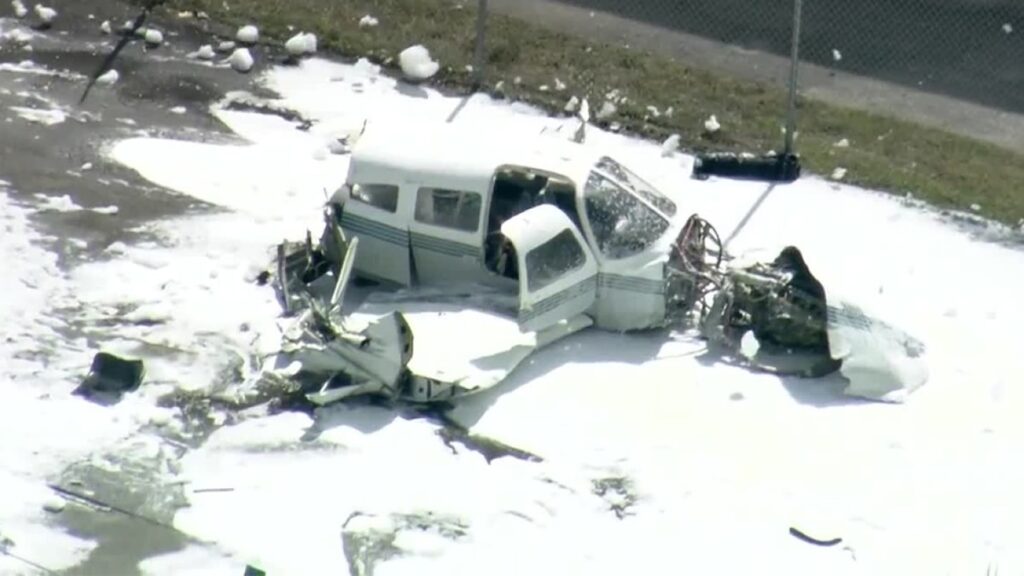In a devastating event that shocked residents of Boca Raton, Florida, a small plane crash took place on a bustling street near the local airport on Friday morning. The incident resulted in the tragic loss of three lives and injured one individual, prompting an investigation by both the Federal Aviation Administration (FAA) and the National Transportation Safety Board (NTSB).
The Timeline of the Incident
According to officials, the accident involved a twin-engine Cessna 310 that had taken off from Boca Raton Airport at approximately 10:00 AM. The aircraft was en route to Tallahassee, but shortly after takeoff, the pilot encountered difficulties. Eyewitness accounts highlight a chaotic scene as moments after the distress call was relayed at 10:12 AM, the aircraft crashed around 10:20 AM into a busy roadway, Military Trail near Glades Road.
“We are deeply saddened to confirm that a plane crash occurred earlier today within our community,”
Boca Raton Mayor Scott Singer expressed in a statement. Tribute to the lives lost and prayers for the victims’ families were echoed across the community, as residents grappled with the sudden loss.
Immediate Aftermath and Community Response
Following the crash, first responders from Boca Raton Fire Rescue quickly rushed to the scene, where they discovered the charred wreckage of the Cessna. According to Assistant Fire Chief Michael LaSalle, all three passengers on board were pronounced dead at the scene. Additionally, a motorist, who suffered non-life-threatening injuries caused by debris from the crash—a serious concern given the crash occurred along a major thoroughfare—was transported to a local hospital for treatment.
Investigation Underway
The NTSB and FAA’s investigation into this tragic incident aims to uncover the causes and circumstances surrounding the crash. Robert Katz, a seasoned commercial pilot and flight instructor known for his expertise, noted that such investigations can take several months, requiring thorough examination of various factors.
Key Areas of Focus
- The pilot’s experience and training records
- The aircraft’s maintenance history and mechanical conditions
- Environmental factors at the time of the incident
Katz emphasized that investigators often start with the wreckage itself. By analyzing the remaining fragments of the airplane, they hope to piece together what might have gone wrong leading up to the crash. The fact that the aircraft reportedly demonstrated mechanical issues prior to the accident has raised particular concerns.
Notably, the Cessna 310 is registered to an LLC based in Delaware, which adds another layer of complexity to the investigation, as the ownership can affect regulatory aspects of aircraft operation.
Community Reactions and Support
The Boca Raton community has been deeply affected by this tragedy, with many residents expressing their sorrow and condolences to the victims’ families. Social media platforms flooded with messages of support as witnesses recounted their experiences. One witness shared a chilling account of hearing the plane zoom by closely before witnessing it crash.
“I heard it like zooming by a couple of times and then whew – a plane crashed.”
This testimony reflects the palpable distress felt throughout the area, as many civilians realized how close they were to a potentially more catastrophic event.
Looking Ahead: Safety Implications
This incident brings into sharp focus the ongoing concerns surrounding aviation safety for small aircraft operating in and around busy urban areas. Local authorities and aviation experts are likely to examine this incident for any possible policy changes or safety recommendations that could prevent similar occurrences in the future.
Conclusion: A Call for Vigilance
The loss of life in this tragic plane crash serves not only as a grim reminder of the risks inherent in aviation but also as a catalyst for discussions regarding safety protocols in general aviation. As investigations continue, the community remains committed to remembering those who lost their lives on this fateful day while advocating for enhanced safety measures.

